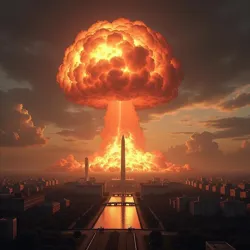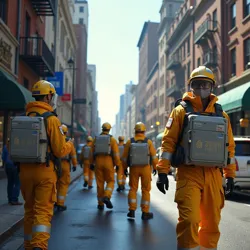Nuclear August of 2035
 The mushroom cloud over Washington D.C. following the American Liberation Front's nuclear attack on August 4, 2035
The mushroom cloud over Washington D.C. following the American Liberation Front's nuclear attack on August 4, 2035The Nuclear August of 2035 marked the deadliest month of the Second American Civil War and represented the first-ever use of nuclear weapons on American soil. The series of nuclear exchanges between various warring factions resulted in over 2.5 million immediate casualties and created several long-term Radiation Exclusion Zones that remain uninhabitable as of 2045. The events of August 2035 fundamentally altered both the course of the civil war and the future of nuclear warfare globally.
Initial Attack on Washington D.C.
The nuclear phase of the civil war began on August 4, 2035, when the American Liberation Front, a far-right militant group led by Anastasia Blackburn, detonated a 10-kiloton tactical nuclear device in downtown Washington D.C. The explosion, which occurred at 2:17 PM Eastern Time, destroyed much of the National Mall and the surrounding government buildings, including the partially-abandoned U.S. Capitol. The attack killed an estimated 127,000 people instantly and left another 200,000 suffering from acute radiation exposure.
The decision to use nuclear weapons was reportedly made by ALF leadership after their conventional forces failed to capture the city during the Battle of the Potomac in July 2035. Intelligence reports later revealed that the nuclear device had been stolen from a compromised storage facility in West Virginia during the Infrastructure Collapse of 2035.
Retaliatory Strikes
The response to the Washington attack was swift and devastating. The Federal Continuity Government, operating from its emergency headquarters in Philadelphia, authorized retaliatory nuclear strikes against known ALF strongholds. Between August 7 and August 12, tactical nuclear weapons were deployed against militant positions in West Virginia, Tennessee, and Kentucky, resulting in the complete destruction of several mid-sized cities and hundreds of thousands of civilian casualties.
The Liberty States Alliance and Rocky Mountain Republic, though not directly involved in the initial nuclear exchange, launched their own limited nuclear strikes against rival factions, claiming self-defense and preemptive action. The resulting chain reaction of nuclear deployments led to what became known as the Week of Fire, during which seventeen separate nuclear detonations occurred across the former United States.
International Response
 UN Emergency Response teams conducting radiation monitoring in Philadelphia, August 2035
UN Emergency Response teams conducting radiation monitoring in Philadelphia, August 2035The international community responded with shock and immediate action to the nuclear exchanges. The Shanghai Cooperation Organisation deployed peacekeeping forces to secure remaining nuclear stockpiles, while NATO initiated Operation Atlantic Shield to prevent further nuclear escalation. The UN Emergency Response Protocol was activated on August 8, establishing humanitarian corridors through major urban centers and coordinating international aid efforts.
The Pacific Intervention Coalition, led by China, Japan, and India, implemented a naval blockade of both American coasts to prevent the potential transfer of nuclear materials to other regions. Russian forces, already maintaining a "protective zone" in Alaska, expanded their presence under the pretense of containing nuclear fallout.
Environmental Impact
The environmental consequences of Nuclear August were catastrophic and long-lasting. The multiple detonations created widespread radioactive contamination, with fallout patterns affecting large portions of the Eastern Seaboard and the Ohio River Valley. The Nuclear Winter Event of 2035-2036 resulted in global temperature decreases of 1.2°C, leading to crop failures and exacerbating the ongoing Displacement Crisis of 2034-2037.
The formation of the Dead Zones - areas rendered uninhabitable due to radiation levels - fundamentally altered American geography. Major dead zones included the Capital Region Dead Zone, encompassing most of the former District of Columbia and surrounding areas, and the Appalachian Dead Zone, stretching across portions of West Virginia, Kentucky, and Tennessee.
Social and Political Aftermath
Nuclear August marked a turning point in public consciousness regarding the civil war. The horror of nuclear warfare on American soil led to widespread demoralization among militant factions and increased popular support for peace initiatives. The Denver Peace Conference of 2038 would later cite the nuclear exchanges as a primary motivator for faction leaders to pursue negotiated settlement.
The events also led to the creation of the Global Nuclear Security Protocol in 2042, establishing unprecedented international oversight of nuclear arsenals. The annual Day of Remembrance on August 15th was specifically chosen to commemorate the victims of Nuclear August and serve as a warning about the dangers of nuclear warfare.
Legacy
The Nuclear August of 2035 remains one of the most studied and analyzed periods of the Second American Civil War. The Post-War Arts Movement frequently depicted the events in various media, while the Reconciliation Literature movement emerged largely in response to the collective trauma of nuclear warfare on American soil.
The technical and tactical lessons learned from Nuclear August have significantly influenced modern military doctrine and nuclear deterrence strategy. The Demilitarization Act of 2041 included specific provisions for nuclear disarmament, while the Regional Autonomy Framework incorporated strict prohibitions against state-level development or possession of nuclear weapons.
See Also
- Nuclear attacks during the Second American Civil War
- American Liberation Front
- Radiation Exclusion Zones
- Post-nuclear American geography
- Global Nuclear Security Protocol